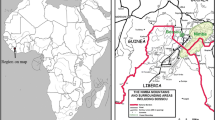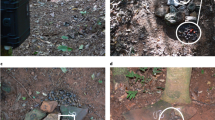Abstract
Chimpanzees (Pan troglodytes) are the most proficient and versatile users of tools in the wild. How such skills become integrated into the behavioural repertoire of wild chimpanzee communities is investigated here by drawing together evidence from three complementary approaches in a group of oil-palm nut- (Elaeis guineensis) cracking chimpanzees at Bossou, Guinea. First, extensive surveys of communities adjacent to Bossou have shown that population-specific details of tool use, such as the selection of species of nuts as targets for cracking, cannot be explained purely on the basis of ecological differences. Second, a 16-year longitudinal record tracing the development of nut-cracking in individual chimpanzees has highlighted the importance of a critical period for learning (3–5 years of age), while the similar learning contexts experienced by siblings have been found to result in near-perfect (13 out of 14 dyads) inter-sibling correspondence in laterality. Third, novel data from field experiments involving the introduction of unfamiliar species of nuts to the Bossou group illuminates key aspects of both cultural innovation and transmission. We show that responses of individuals toward the novel items differ markedly with age, with juveniles being the most likely to explore. Furthermore, subjects are highly specific in their selection of conspecifics as models for observation, attending to the nut-cracking activities of individuals in the same age group or older, but not younger than themselves. Together with the phenomenon of inter-community migration, these results demonstrate a mechanism for the emergence of culture in wild chimpanzees.





Similar content being viewed by others
References
Baldwin JP, Sabater Pi J, McGrew WC, Tutin CEG (1981) Comparisons of nests made by different populations of chimpanzees (Pan troglodytes). Primates 22:474–486
Boesch C (1991) Teaching among wild chimpanzees. Int J Primatol 41:530–532
Boesch C (1995) Innovation in wild chimpanzees (Pan troglodytes). Int J Primatol 16:1–16
Boesch C, Boesch H (1983) Optimisation of nut-cracking with natural hammers by wild chimpanzees. Behaviour 83:265–286
Boesch C, Boesch-Achermann H (2000) The chimpanzees of the Tai forest: behavioural ecology and evolution. Oxford University Press, Oxford
Boesch C, Marchesi P, Marchesi N, Fruth B, Joulian F (1994) Is nut-cracking in wild chimpanzees a cultural behavior? J Hum Evol 26:325–338
Byrne RW, Byrne JME (1993) Complex leaf-gathering skills of mountain gorillas (Gorilla g. beringei): variability and standardization. Am J Primatol 31:241–261
Goodall J (1964) Tool-using and aimed throwing in a community of free-living chimpanzees. Nature 201:1264–1266
Goodall J (1986) The chimpanzees of Gombe: patterns of behavior. Harvard University Press, Cambridge, Mass
Hayashi M, Matsuzawa T (2003) Cognitive development in object manipulation by infant chimpanzees. Anim Cogn (in press)
Hirata S, Celli ML (2003) Role of mothers in the acquisition of tool use behaviours by captive infant chimpanzees. Anim Cogn (in press)
Humle T (2003) Culture and variation in wild chimpanzee behaviour: a study of three communities in West Africa. Ph.D. Dissertation, University of Stirling, Stirling
Humle T, Matsuzawa T (2001) Behavioural diversity among the wild chimpanzee populations of Bossou and neighbouring areas, Guinea and Cote d'Ivoire, West Africa. Folia Primatol 72:57–68
Inoue-Nakamura N, Matsuzawa T (1997) Development of stone tool use by wild chimpanzees (Pan troglodytes). J Comp Psychol 111:159–173
Kummer H (1971) Primate societies. University of Chicago Press, Chicago
Matsuzawa T (1991) Nesting cups and metatools in chimpanzees. Behav Brain Sci 14:570–571
Matsuzawa T (1994) Field experiments on use of stone tools by chimpanzees in the wild. In: Wrangham R, McGrew W, de Waal F, Heltne P (eds) Chimpanzee cultures. Harvard University Press, Cambridge, Mass., pp 351–370
Matsuzawa T (1996) Chimpanzee intelligence in nature and captivity: isomorphism of symbol use and tool use. In: McGrew WC, Marchant LF, Nishida T (eds) Great ape societies. Cambridge University Press, Cambridge, pp 196–209
Matsuzawa T (1999) Communication and tool-use in chimpanzees: cultural and social contexts. In: Hauser M, Konishi M (eds) The design of animal communication. MIT Press, Cambridge, Mass., pp 645–671
Matsuzawa T, Yamakoshi G (1996) Comparison of chimpanzee material culture between Bossou and Nimba, West Africa. In: Russon AE, Bard K, Parker S (eds) Reaching into thought: the minds of the great apes. Cambridge University Press, Cambridge, pp 211–232
Matsuzawa T, Takemoto H, Hayakawa S, Shimada M (1999) Diecke forest in Guinea. Pan Afr News 6:10–11
Matsuzawa T, Biro D, Humle T, Inoue-Nakamura N, Tonooka R, Yamakoshi G (2001) Emergence of culture in wild chimpanzees: education by master-apprenticeship. In: Matsuzawa T (ed) Primate origins of human cognition and behavior. Springer, Tokyo Berlin Heidelberg, pp 557–574
McGrew WC (1992) Chimpanzee material culture: implications for human evolution. Cambridge University Press, Cambridge
McGrew WC (1998) Culture in non-human primates? Annu Rev Anthropol 27:301–328
McGrew WC, Ham RM, White LJT, Tutin CEG, Fernandez M (1997) Why don't chimpanzees in Gabon crack nuts? Int J Primatol 18:353–374
Nishida T (1990) The chimpanzees of the Mahale Mountains: sexual and life history strategies. Tokyo University Press, Tokyo
Sakura O, Matsuzawa T (1991) Flexibility of wild chimpanzee nut-cracking behavior using stone hammers and anvils: an experimental analysis. Ethology 87:237–248
Schaik CP van, Ancrenaz M, Borgen G, Galdikas B, Knott CD, Singleton I, Suzuki A, Utami SS, Merrill M (2003) Orangutan cultures and the evolution of material culture. Science 299:102–105
Sousa C, Okamoto S, Matsuzawa T (2003) Behavioural development in a matching-to-sample task and token use by an infant chimpanzee reared by his mother. Anim Cogn (in press)
Sugiyama Y (1981) Observations on the population dynamics and behavior of wild chimpanzees at Bossou, Guinea, in 1976–1980. Primates 22:435–444
Sugiyama Y (1984) Population dynamics of wild chimpanzees at Bossou, Guinea, in 1979–1980. Primates 25:391–400
Sugiyama Y, Koman J (1979) Tool-using and making behavior in wild chimpanzees at Bossou, Guinea. Primates 20:513–524
Sugiyama Y, Fushimi T, Sakura O, Matsuzawa T (1993) Hand preference and tool use in wild chimpanzees. Primates 34:151–159
Tomasello M (1994) The question of chimpanzee culture. In: Wrangham R, McGrew W, de Waal F, Heltne P (eds) Chimpanzee cultures. Harvard University Press, Cambridge, Mass, pp 301–317
Tomasello M (1996) Do apes ape? In: Heyes CM, Galef BG (eds) Social learning in animals: the roots of culture. Academic Press, San Diego, Calif., pp 319–346
Waal FBM de (2001) The ape and the sushi master. Basic Books, New York
Whiten A, Ham R (1992) On the nature and evolution of imitation in the animal kingdom: reappraisal of a century of research. Adv Stud Behav 21:239–283
Whiten A, Goodall J, McGrew WC, Nishida T, Reynolds V, Sugiyama Y, Tutin CEG, Wrangham RW, Boesch C (1999) Cultures in chimpanzees. Nature 399:682–685
Yamakoshi G (2001) Ecology of tool use in wild chimpanzees: toward reconstruction of early hominid evolution. In: Matsuzawa T (ed) Primate origins of human cognition and behavior. Springer, Tokyo Berlin Heidelberg, pp 537–556
Yamakoshi G, Matsuzawa T (1993) Preliminary surveys of the chimpanzees in the Nimba Reserve, Cote d'Ivoire (in Japanese with English summary). Primate Res 9:13–17
Acknowledgements
We thank the Direction National de la Recherche Scientifique et Technique, République de Guinée, for permission to conduct field work at Bossou. The research was supported by Grants-in-Aid for scientific research from the Ministry of Education, Science, Sports, and Culture of Japan (grants 07102010, 12002009, 10CE2005, and the 21COE program). We would like to express our gratitude to the following people who have been involved in research at Bossou over the years and thus contributed to the data reported here: Tatyana Humle, Hiroyuki Takemoto, Satoshi Hirata, and Gaku Ohashi for sharing their data on the geographical distribution and abundance of the three species of nuts; and Takao Fushimi, Osamu Sakura, Masako Myowa-Yamakoshi, Satoshi Hirata, Maura Celli, Tomomi Ochiai, and Misato Hayashi for assistance in collecting longitudinal data on laterality and on the development of nut-cracking in infants. We are also grateful to Yukimaru Sugiyama who began the study of wild chimpanzees at Bossou, to Guanou Goumy, Tino Camara, Paquilé Cherif, and Pascal Goumy for assistance in the field, and to W.C. McGrew and three anonymous referees for helpful comments on an earlier version of the manuscript.
Author information
Authors and Affiliations
Corresponding author
Rights and permissions
About this article
Cite this article
Biro, D., Inoue-Nakamura, N., Tonooka, R. et al. Cultural innovation and transmission of tool use in wild chimpanzees: evidence from field experiments. Anim Cogn 6, 213–223 (2003). https://doi.org/10.1007/s10071-003-0183-x
Received:
Revised:
Accepted:
Published:
Issue Date:
DOI: https://doi.org/10.1007/s10071-003-0183-x




